ഏഷ്യൻ ദിനോസറുകളുടെ പട്ടിക
From Wikipedia, the free encyclopedia
Remove ads
ഇത് ഏഷ്യയിൽ നിന്നും ഫോസ്സിലുകൾ കണ്ടു കിട്ടിയിട്ടുള്ള ദിനോസറുകളുടെ പട്ടികയാണ്. മിസോസോയിക് കാലഘട്ടത്തിന്റെ ഭൂരിഭാഗവും ഇന്ത്യൻ ഉപഭൂഖണ്ഡം ഏഷ്യയുടെ ഭാഗം അല്ലാത്തതുകൊണ്ട് ഇന്ത്യൻ ഭൂഖണ്ഡത്തിൽ നിന്നുമുള്ള ദിനോസറുകളെ ഈ പട്ടികയിൽ ഉൽപെടുത്തിയിട്ടില്ല. ഇന്ത്യൻ ഉപഭൂഖണ്ഡമൊഴികെയുള്ള മറ്റു ഏഷ്യൻ ഭൂപ്രദേശങ്ങളിൽ നിന്നും കിട്ടിയ ദിനോസർ ഫോസ്സിലുകളുടെ വിവരങ്ങളാണ് ഇവിടെ നൽകിയിരിക്കുന്നത്. മറ്റു വൻകരകളെ അപേക്ഷിച്ച് എറ്റവും കുടുതൽ ദിനോസറുകളെ കണ്ടു കിട്ടിയിട്ടുള്ളത് ഏഷ്യയിൽ നിന്നുമാണ്.
ഈ ലേഖനത്തിലെ ഖണ്ഡികയോ, ലേഖനത്തിന്റെ ഒരു ഭാഗമോ മലയാളത്തിലേക്ക് വിവർത്തനം ചെയ്യേണ്ടതാണ്. താങ്കൾക്ക് വിവർത്തന പ്രവർത്തികൾ നടക്കുന്നു വിവർത്തനം ചെയ്യാമെന്നുറപ്പുണ്ടെങ്കിൽ, സധൈര്യം ഈ താൾ തിരുത്തി വിവർത്തനം ചെയ്യാവുന്നതാണ്. |
Remove ads
ഏഷ്യൻ ദിനോസർ പട്ടിക
സാധുവായ ജനുസ്സുകൾ
കൂടുതൽ വിവരങ്ങൾ Name, Year ...
| Name | Year | Formation | Location | Notes | Images |
|---|---|---|---|---|---|
| Abdarainurus | 2020 | Alagteeg Formation (അന്ത്യ ക്രിറ്റേഷ്യസ്, Santonian to Campanian) | പരിണാമസിദ്ധാന്ത പ്രാകാരമുള്ള നിലനിൽപ്പ് സംശയകരമാണ്. ഒരു പക്ഷേ സൗറോപോഡ്കളുടെ (മാക്രോനർനിയെൻസ്) പുതിയ ഒരു ജീവശാഖ ഉരുത്തിരിഞ്ഞേക്കാം ഭാവിയിൽ .[1] |  | |
| അബ്രോസോറസ് | 1989 | Shaximiao Formation (മധ്യ ട്രയാസ്സിക്, Bathonian to Callovian) | അസ്വാഭാവികമായ വലുപ്പമുള്ള ഫെൻസ്ട്ര ഉണ്ടായിരുന്നു . |  | |
| അക്കീലോബറ്റോർ | 1999 | Bayan Shireh Formation (അന്ത്യ ക്രിറ്റേഷ്യസ്, Cenomanian to Santonian) | ഡ്രോമയിയോസോറിഡകളിൽ വെച്ച് വലിയ ഇനം[2] |  | |
| അഡസോറസ് | 1983 | Nemegt Formation (അന്ത്യ ക്രിറ്റേഷ്യസ്, Maastrichtian) | മറ്റു ഡ്രോമയിയോസോറിഡകളേ അപേക്ഷിച്ചു കാലിലെ അരിവാൾ ആകൃതിയിൽ ഉള്ള നഖം വളരെ ചെറുതായിരുന്നു . |  | |
| Aepyornithomimus | 2017 | ജെഡോച്ചട്ട ഫോർമെഷൻ (അന്ത്യ ക്രിറ്റേഷ്യസ്, Campanian) | വരണ്ട മരുഭൂമി സമാനമായ പ്രദേശത്തു നിന്നു കിട്ടിയ ഓർനിതോമിമോസൌർ |  | |
| Agilisaurus | 1983 | Shaximiao Formation (മധ്യ ട്രയാസ്സിക്, Bathonian to Callovian) | ഒരു മ്യൂസിയത്തിന്റെ നിർമാണവേളയിൽ കണ്ടെത്തിയ ഹോളോ ടൈപ്പ് സ്പെസിമെൻ |  | |
| Albalophosaurus | 2009 | Kuwajima Formation (തുടക്ക ക്രിറ്റേഷ്യസ്, Valanginian to Hauterivian) | തലയോട്ടിയുടെ ചില ഭാഗങ്ങൾ മാത്രമേ ലഭ്യമായിട്ടുള്ളൂ . |  | |
| Albinykus | 2011 | Javkhlant Formation (അന്ത്യ ക്രിറ്റേഷ്യസ്, Santonian) | പക്ഷികളോട് സമാനമായി കാലുകൾ ശരീരത്തിനടിയിൽ വരുന്ന രീതിയിൽ ഇരിക്കുന്ന ഫോസിൽ ആണ് കണ്ടു കിട്ടിയിട്ടുള്ളത് . | ||
| Alectrosaurus | 1933 | Bayan Shireh Formation?, Iren Dabasu Formation (അന്ത്യ ക്രിറ്റേഷ്യസ്, Cenomanian to Santonian) | കാലിന്റെ ഫോസിൽ പഠനത്തിൽ നിന്നും വളരെ വേഗത്തിൽ ഓടി ഇരപിടിക്കാൻ കഴിവുള്ളവയാണ് എന്ന് തിരിച്ചറിഞ്ഞു.[3] |  | |
| Alioramus | 1976 | Nemegt Formation (അന്ത്യ ക്രിറ്റേഷ്യസ്, Maastrichtian) | Possessed an elongated snout with a row of short crests |  | |
| Almas | 2017 | Djadochta Formation (അന്ത്യ ക്രിറ്റേഷ്യസ്, Campanian) | Preserved alongside eggshells which may have come from a troodontid[4] |  | |
| Altirhinus | 1998 | Khuren Dukh Formation (തുടക്ക ക്രിറ്റേഷ്യസ്, Barremian to Albian) | Had a distinctive, elevated nasal bone which supported a large nasal cavity |  | |
| Alxasaurus | 1993 | Bayin-Gobi Formation (തുടക്ക ക്രിറ്റേഷ്യസ്, Albian) | Most of the skeleton is known, which allowed researchers to connect therizinosaurs to other theropods |  | |
| Ambopteryx | 2019 | Unnamed formation (അന്ത്യ ട്രയാസ്സിക്, Oxfordian) | Preserves stomach contents containing gastroliths and fragments of bone, suggesting an omnivorous diet |  | |
| Amtocephale | 2011 | Bayan Shireh Formation (അന്ത്യ ക്രിറ്റേഷ്യസ്, Turonian to Santonian) | One of the oldest known pachycephalosaurs |  | |
| Amurosaurus | 1991 | Udurchukan Formation (അന്ത്യ ക്രിറ്റേഷ്യസ്, Maastrichtian) | One specimen may have come from an individual with a limp[5] |  | |
| Analong | 2020 | Chuanjie Formation (മധ്യ ട്രയാസ്സിക്, Bajocian) | Originally described as a specimen of Chuanjiesaurus but assigned a new genus due to several morphological differences | ||
| Anchiornis | 2009 | Tiaojishan Formation (അന്ത്യ ട്രയാസ്സിക്, Oxfordian) | Analysis of fossilized melanosomes suggest a mostly gray or black body, white and black patterns on its wings, and a red head crest[6] |  | |
| Anhuilong | 2020 | Hongqin Formation (മധ്യ ട്രയാസ്സിക്, Aalenian to Callovian) | Closely related to Huangshanlong and Omeisaurus, all forming an exclusive clade of mamenchisaurids |  | |
| Anomalipes | 2018 | Wangshi Group (അന്ത്യ ക്രിറ്റേഷ്യസ്, Maastrichtian) | May have been closely related to Gigantoraptor despite its significantly smaller size[7] |  | |
| Anserimimus | 1988 | Nemegt Formation (അന്ത്യ ക്രിറ്റേഷ്യസ്, Maastrichtian) | Had powerful forelimbs with uniquely straight, flattened claws |  | |
| Aorun | 2013 | Shishugou Formation, (അന്ത്യ ട്രയാസ്സിക്, Oxfordian) | Potentially a basal member of the alvarezsaurian lineage[8] |  | |
| Aralosaurus | 1968 | Bostobe Formation, (അന്ത്യ ക്രിറ്റേഷ്യസ്, Santonian to Campanian) | Its crest has been interpreted as being arch-shaped as in kritosaurin hadrosaurs, but this cannot be confirmed |  | |
| Archaeoceratops | 1997 | Xinminbao Group (തുടക്ക ക്രിറ്റേഷ്യസ്, Barremian) | Had no horns and only the beginnings of a frill |  | |
| Archaeornithoides | 1992 | Djadochta Formation (അന്ത്യ ക്രിറ്റേഷ്യസ്, Campanian) | Known from only a partial skull with scratches that may have been created by a small mammal[9] |  | |
| Archaeornithomimus | 1972 | Bissekty Formation?, Iren Dabasu Formation (അന്ത്യ ക്രിറ്റേഷ്യസ്, Cenomanian to Turonian) | Unlike other ornithomimosaurs, its feet were not arctometatarsalian |  | |
| Arkharavia | 2010 | Udurchukan Formation (അന്ത്യ ക്രിറ്റേഷ്യസ്, Maastrichtian) | Described from a series of vertebrae, several of which were found to not belong to this taxon[10] |  | |
| Arstanosaurus | 1982 | Bostobe Formation (അന്ത്യ ക്രിറ്റേഷ്യസ്, Santonian to Campanian) | Poorly known | ||
| Asiaceratops | 1989 | Khodzhakul Formation (അന്ത്യ ക്രിറ്റേഷ്യസ്, Cenomanian) | Potentially a leptoceratopsid[11] | ||
| Asiatosaurus | 1924 | Öösh Formation, Xinlong Formation (തുടക്ക ക്രിറ്റേഷ്യസ്, Aptian) | Two species have been named but both are only known from extremely scant remains |  | |
| Auroraceratops | 2005 | Xinminbao Group (തുടക്ക ക്രിറ്റേഷ്യസ്, Aptian) | Known from more than eighty specimens, including complete skeletons |  | |
| Aurornis | 2013 | Tiaojishan Formation (അന്ത്യ ട്രയാസ്സിക്, Oxfordian) | If an avialan as originally described it would be one of the oldest members of the group |  | |
| Avimimus | 1981 | Barun Goyot Formation, Nemegt Formation (അന്ത്യ ക്രിറ്റേഷ്യസ്, Campanian to Maastrichtian) | Bonebed remains indicate a gregarious lifestyle; it may have formed age-segregated herds for lekking or flocking purposes[12] |  | |
| Bactrosaurus | 1933 | Iren Dabasu Formation, Majiacun Formation? (അന്ത്യ ക്രിറ്റേഷ്യസ്, Cenomanian to Santonian?) | Remains of at least six individuals are known, making up much of the skeleton |  | |
| Bagaceratops | 1975 | Barun Goyot Formation, Bayan Mandahu Formation, Djadochta Formation? (അന്ത്യ ക്രിറ്റേഷ്യസ്, Maastrichtian) | May have been a direct descendant of Protoceratops which it physically resembles[13] |  | |
| Bagaraatan | 1996 | Nemegt Formation (അന്ത്യ ക്രിറ്റേഷ്യസ്, Maastrichtian) | Combines traits of several theropod groups, possibly due to being chimaeric[14] |  | |
| Bainoceratops | 2003 | Djadochta Formation (അന്ത്യ ക്രിറ്റേഷ്യസ്, Campanian) | Its supposedly diagnostic features may fall within Protoceratops variation[15] | ||
| Banji | 2010 | Nanxiong Formation (അന്ത്യ ക്രിറ്റേഷ്യസ്, Maastrichtian) | Vertical striations adorned the sides of its crest |  | |
| Bannykus | 2018 | Bayin-Gobi Formation (തുടക്ക ക്രിറ്റേഷ്യസ്, Barremian to Aptian) | Exhibited a transitional hand morphology for an alvarezsaur, having three fingers of roughly equal length with the first being robust |  | |
| Baotianmansaurus | 2009 | Gaogou Formation (അന്ത്യ ക്രിറ്റേഷ്യസ്, Cenomanian to Turonian) | Large but known from only a few bones |  | |
| Barsboldia | 1981 | Nemegt Formation (അന്ത്യ ക്രിറ്റേഷ്യസ്, Maastrichtian) | Possessed elongated neural spines particularly above the hips |  | |
| Bashanosaurus | 2022 | Shaximiao Formation (മധ്യ ട്രയാസ്സിക്, Bajocian) | Its skeleton combines traits of stegosaurs and more basal thyreophorans | ||
| Bashunosaurus | 2004 | Shaximiao Formation (മധ്യ ട്രയാസ്സിക്, Callovian) | Although described as a macronarian, this has yet to be rigorously tested[16] | ||
| Batyrosaurus | 2012 | Bostobe Formation (അന്ത്യ ക്രിറ്റേഷ്യസ്, Santonian to Campanian) | Remains originally identified as Arstanosaurus |  | |
| Bayannurosaurus | 2018 | Bayin-Gobi Formation (തുടക്ക ക്രിറ്റേഷ്യസ്, Aptian) | Known from a well-preserved, almost complete skeleton |  | |
| Beg | 2020 | Ulaanoosh Formation (തുടക്ക ക്രിറ്റേഷ്യസ് to അന്ത്യ ക്രിറ്റേഷ്യസ്, Albian to Cenomanian) | Its preserved skull has a rugose texture |  | |
| Beibeilong | 2017 | Gaogou Formation (അന്ത്യ ക്രിറ്റേഷ്യസ്, Cenomanian to Turonian) | Similar to but more basal than Gigantoraptor.[17] Known from only a single embryo still in its egg |  | |
| Beipiaosaurus | 1999 | Yixian Formation (തുടക്ക ക്രിറ്റേഷ്യസ്, Aptian) | Preserves evidence of downy feathers as well as a secondary coat of simpler "elongated broad filamentous feathers" or EBFFs[18] |  | |
| Beishanlong | 2010 | Xinminbao Group (തുടക്ക ക്രിറ്റേഷ്യസ്, Aptian to Albian) | Lacked the elongated claws of more derived ornithomimosaurs | 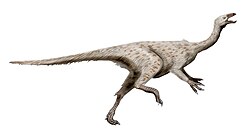 | |
| Bellusaurus | 1990 | Shishugou Formation (മധ്യ ട്രയാസ്സിക്, Bajocian) | Known from a bone bed with the remains of seventeen juvenile specimens |  | |
| Bienosaurus | 2001 | Lufeng Formation (തുടക്ക ജുറാസ്സിക്, Sinemurian) | Potentially synonymous with Tatisaurus[19] |  | |
| Bissektipelta | 2004 | Bissekty Formation (അന്ത്യ ക്രിറ്റേഷ്യസ്, Turonian to Coniacian) | Analysis of its braincase suggests poor hearing and eyesight but good olfaction and taste; it has been suggested to be a filter feeder[20] | ||
| Bolong | 2010 | Yixian Formation (തുടക്ക ക്രിറ്റേഷ്യസ്, Aptian) | Originally known from only a skull; an almost complete skeleton was described in 2013[21] | ||
| Borealosaurus | 2004 | Sunjiawan Formation (അന്ത്യ ക്രിറ്റേഷ്യസ്, Cenomanian to Turonian) | Its caudal vertebrae were distinctively opisthocoelous | ||
| Borogovia | 1987 | Nemegt Formation (അന്ത്യ ക്രിറ്റേഷ്യസ്, Maastrichtian) | Had a uniquely straight and flattened sickle claw, which may have had a weight-bearing function |  | |
| Breviceratops | 1990 | Barun Goyot Formation (അന്ത്യ ക്രിറ്റേഷ്യസ്, Campanian) | Only known from juvenile remains but can be distinguished from other protoceratopsids |  | |
| Brohisaurus | 2003 | Sembar Formation (അന്ത്യ ട്രയാസ്സിക്, Kimmeridgian) | Possibly an early titanosauriform | ||
| Byronosaurus | 2000 | Djadochta Formation (അന്ത്യ ക്രിറ്റേഷ്യസ്, Campanian) | Two juvenile skulls were found in an oviraptorid nest and claimed to be evidence for nest parasitism in this taxon, but both their identity and taphonomy have been questioned[4][22] |  | |
| Caenagnathasia | 1994 | Bissekty Formation (അന്ത്യ ക്രിറ്റേഷ്യസ്, Turonian to Coniacian) | One of the oldest and smallest known caenagnathoids |  | |
| Caihong | 2018 | Tiaojishan Formation (അന്ത്യ ട്രയാസ്സിക്, Oxfordian) | Possessed platelet-shaped melanosomes that produced iridesence as in modern trumpeters |  | |
| Caudipteryx | 1998 | Yixian Formation (തുടക്ക ക്രിറ്റേഷ്യസ്, Barremian) | Two species are known. At least C. zoui did not have secondary feathers attached to the lower arm |  | |
| Ceratonykus | 2009 | Barun Goyot Formation (അന്ത്യ ക്രിറ്റേഷ്യസ്, Campanian) | Several osteological features were described as similar to ornithischians[23] |  | |
| Changchunsaurus | 2005 | Quantou Formation (തുടക്ക ക്രിറ്റേഷ്യസ് to അന്ത്യ ക്രിറ്റേഷ്യസ്, Albian to Cenomanian) | Had wavy enamel on its leaf-shaped teeth that made them more resistant to wear; this feature is also present in hadrosaurs[24] |  | |
| Changmiania | 2020 | Yixian Formation (തുടക്ക ക്രിറ്റേഷ്യസ്, Barremian) | Preserved in a curled-up position as if sleeping in a potential burrow |  | |
| Changyuraptor | 2014 | Yixian Formation (തുടക്ക ക്രിറ്റേഷ്യസ്, Barremian) | The largest microraptorian dromaeosaurid known. Had tail feathers almost a foot long[25] |  | |
| Chaoyangsaurus | 1999 | Tuchengzi Formation (അന്ത്യ ട്രയാസ്സിക്, Tithonian) | Known by a number of alternate spellings (e.g. Chaoyangosaurus, Chaoyoungosaurus) before its formal description | 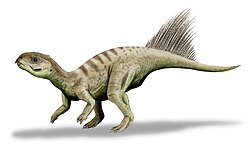 | |
| Charonosaurus | 2000 | Yuliangze Formation (അന്ത്യ ക്രിറ്റേഷ്യസ്, Maastrichtian) | May have had a long, backwards-arcing crest similar to that of Parasaurolophus |  | |
| Chialingosaurus | 1959 | Shaximiao Formation (അന്ത്യ ട്രയാസ്സിക്, Oxfordian to Kimmeridgian) | Had both large plates and smaller spines, similar to Kentrosaurus |  | |
| Chiayusaurus | 1953 | Hasandong Formation, Xinminbao Group (തുടക്ക ക്രിറ്റേഷ്യസ്, Barremian to Albian) | Two species have been named, both from teeth. Those of C. lacustris are apparently indistinguishable to those of Euhelopus[26] or Mamenchisaurus[27] | ||
| Chilantaisaurus | 1964 | Ulansuhai Formation (അന്ത്യ ക്രിറ്റേഷ്യസ്, Turonian) | Had a particularly hooked claw on its first finger |  | |
| Chingkankousaurus | 1958 | Wangshi Group (അന്ത്യ ക്രിറ്റേഷ്യസ്, Santonian to Campanian) | Known from only a scapula. Possibly a tyrannosauroid[28] | ||
| Chinshakiangosaurus | 1992 | Fengjiahe Formation (തുടക്ക ജുറാസ്സിക്, Hettangian) | Had a U-shaped snout that may have supported fleshy cheeks, an adaptation to bulk feeding | ||
| Choyrodon | 2018 | Khuren Dukh Formation (തുടക്ക ക്രിറ്റേഷ്യസ്, Albian) | It had an enlarged nose similar to its contemporary, Altirhinus, but it is most likely a separate taxon[29] |  | |
| Chuandongocoelurus | 1984 | Shaximiao Formation (മധ്യ ട്രയാസ്സിക്, Bathonian to Callovian) | A tetanuran of uncertain relationships | 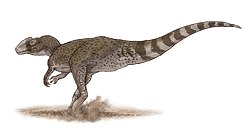 | |
| Chuanjiesaurus | 2000 | Chuanjie Formation (മധ്യ ട്രയാസ്സിക്, Bathonian) | One of the more derived mamenchisaurids[30] |  | |
| Chuanqilong | 2014 | Jiufotang Formation (തുടക്ക ക്രിറ്റേഷ്യസ്, Barremian to Aptian) | May have been the adult form of the coeval Liaoningosaurus[31] |  | |
| Chungkingosaurus | 1983 | Shaximiao Formation (അന്ത്യ ട്രയാസ്സിക്, Oxfordian) | May have possessed at least six thagomizer spikes; the rearmost pair was mounted horizontally, directed outwards and backwards |  | |
| Chuxiongosaurus | 2010 | Lufeng Formation (തുടക്ക ജുറാസ്സിക്, Hettangian to Pliensbachian) | Potentially a synonym of Jingshanosaurus[32] | ||
| Citipati | 2001 | Djadochta Formation (അന്ത്യ ക്രിറ്റേഷ്യസ്, Campanian to Maastrichtian) | Had a distinctive triangular crest. A referred specimen known as the Zamyn Khondt oviraptorid possessed the familiar rectangular domed crest in most depictions of Oviraptor, but likely does not belong to that genus or Citipati[33] |  | |
| Conchoraptor | 1986 | Barun Goyot Formation, Nemegt Formation (അന്ത്യ ക്രിറ്റേഷ്യസ്, Maastrichtian) | Named for a hypothesized diet of shellfish, but this cannot be confirmed |  | |
| Corythoraptor | 2017 | Nanxiong Formation (അന്ത്യ ക്രിറ്റേഷ്യസ്, Maastrichtian) | Its crest was vertical and rectangular, not unlike that of a cassowary |  | |
| Crichtonpelta | 2015 | Sunjiawan Formation (അന്ത്യ ക്രിറ്റേഷ്യസ്, Cenomanian) | Originally named as a second species of Crichtonsaurus | ||
| Crichtonsaurus | 2002 | Sunjiawan Formation (അന്ത്യ ക്രിറ്റേഷ്യസ്, Cenomanian to Turonian) | Sometimes reconstructed with semicircular osteoderms vaguely similar to the plates of stegosaurs |  | |
| Daanosaurus | 2005 | Shaximiao Formation (അന്ത്യ ട്രയാസ്സിക്, Oxfordian to Tithonian) | Only known from the remains of a juvenile | ||
| Daliansaurus | 2017 | Yixian Formation (തുടക്ക ക്രിറ്റേഷ്യസ്, Barremian) | Had an enlarged claw on the fourth toe comparable in size to the sickle claw on its second |  | |
| Dashanpusaurus | 2005 | Shaximiao Formation (മധ്യ ട്രയാസ്സിക്, Callovian) | One of the basalmost and earliest known macronarians[34] | ||
| Datanglong | 2014 | Xinlong Formation (തുടക്ക ക്രിറ്റേഷ്യസ്, Barremian to Albian) | Had a uniquely pneumatized ilium similar to megaraptorans | ||
| Datonglong | 2016 | Huiquanpu Formation (അന്ത്യ ക്രിറ്റേഷ്യസ്, Cenomanian to Campanian) | Precise dating uncertain | ||
| Datousaurus | 1984 | Shaximiao Formation (മധ്യ ട്രയാസ്സിക് to അന്ത്യ ട്രയാസ്സിക്, Callovian to Oxfordian) | One of the rarer sauropods of the Shaximiao, known from only two skeletons and a large, deep skull |  | |
| Daurlong | 2022 | Longjiang Formation (തുടക്ക ക്രിറ്റേഷ്യസ്, Aptian) | Preserves remains of an intestinal tract | 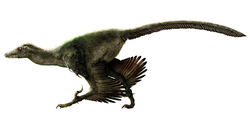 | |
| Daxiatitan | 2008 | Hekou Group (തുടക്ക ക്രിറ്റേഷ്യസ്, Barremian) | Large and very long-necked |  | |
| Deinocheirus | 1970 | Nemegt Formation (അന്ത്യ ക്രിറ്റേഷ്യസ്, Maastrichtian) | Had a suite of unique features, most notably a hump supported by elongated neural spines | 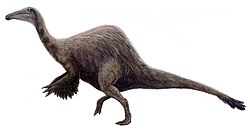 | |
| Dilong | 2004 | Yixian Formation (തുടക്ക ക്രിറ്റേഷ്യസ്, Barremian) | Preserves evidence of a coating of simple feathers |  | |
| Dongbeititan | 2007 | Yixian Formation (തുടക്ക ക്രിറ്റേഷ്യസ്, Barremian) | A theropod tooth has been found encrusted in one of its ribs[35] |  | |
| Dongyangopelta | 2013 | Chaochuan Formation (തുടക്ക ക്രിറ്റേഷ്യസ് to അന്ത്യ ക്രിറ്റേഷ്യസ്, Albian to Cenomanian) | Coexisted with Zhejiangosaurus but could be distinguished based on subtle osteological features[36] | ||
| Dongyangosaurus | 2008 | Jinhua Formation (അന്ത്യ ക്രിറ്റേഷ്യസ്, Turonian to Coniacian) | Its phylogenetic placement is uncertain |  | |
| Dzharaonyx | 2022 | Bissekty Formation (അന്ത്യ ക്രിറ്റേഷ്യസ്, Turonian) | One of the oldest known parvicursorines | ||
| Dzharatitanis | 2021 | Bissekty Formation (അന്ത്യ ക്രിറ്റേഷ്യസ്, Turonian) | Originally described as a rebbachisaurid[37] but later reinterpreted as a titanosaur with possible lognkosaurian affinities[38] |  | |
| Elmisaurus | 1981 | Nemegt Formation (അന്ത്യ ക്രിറ്റേഷ്യസ്, Maastrichtian) | One of the most complete caenagnathids known |  | |
| Embasaurus | 1931 | Neocomian Sands (തുടക്ക ക്രിറ്റേഷ്യസ്, Berriasian) | Known from only two vertebrae |  | |
| Enigmosaurus | 1983 | Bayan Shireh Formation (അന്ത്യ ക്രിറ്റേഷ്യസ്, Cenomanian to Santonian) | Had a large, backwards-pointing pelvis |  | |
| Eomamenchisaurus | 2008 | Zhanghe Formation (മധ്യ ട്രയാസ്സിക്, Aalenian to Callovian) | One of the oldest and most basal mamenchisaurids | ||
| Eosinopteryx | 2013 | Tiaojishan Formation (അന്ത്യ ട്രയാസ്സിക്, Oxfordian) | Described as lacking advanced tail feathers and long "hind wings", unlike other paravians, but this may be an artifact of preservation[39] |  | |
| Epidexipteryx | 2008 | Haifanggou Formation (മധ്യ ട്രയാസ്സിക്, Callovian) | Supported four long feathers from an abbreviated tail |  | |
| Equijubus | 2003 | Xinminbao Group (തുടക്ക ക്രിറ്റേഷ്യസ്, Albian) | A grazer that preserves the oldest known evidence of grass-eating[40] |  | |
| Erketu | 2006 | Bayan Shireh Formation (അന്ത്യ ക്രിറ്റേഷ്യസ്, Cenomanian to Santonian) | May have had the longest neck of any dinosaur relative to its body |  | |
| Erliansaurus | 2002 | Iren Dabasu Formation (അന്ത്യ ക്രിറ്റേഷ്യസ്, Cenomanian) | Had long, curved claws on its fingers |  | |
| Erlikosaurus | 1980 | Bayan Shireh Formation (അന്ത്യ ക്രിറ്റേഷ്യസ്, Cenomanian to Santonian) | Preserves the most complete skull known from any therizinosaur |  | |
| Eshanosaurus | 2001 | Lufeng Formation (തുടക്ക ജുറാസ്സിക്, Hettangian) | Has been suggested to be the oldest known therizinosaur |  | |
| Euhelopus | 1956 | Meng-Yin Formation (തുടക്ക ക്രിറ്റേഷ്യസ്, Berriasian to Valanginian) | Originally believed to have lived in a marshy environment |  | |
| Euronychodon | 1991 | Bissekty Formation (അന്ത്യ ക്രിറ്റേഷ്യസ്, Turonian) | Type species was found in Portugal. The Asian species may represent a form taxon of improperly developed teeth[41] | ||
| Ferganasaurus | 2003 | Balabansai Formation (മധ്യ ട്രയാസ്സിക്, Callovian) | Claimed to have two hand claws, but this is disputed[42] | ||
| Ferganocephale | 2005 | Balabansai Formation (മധ്യ ട്രയാസ്സിക്, Callovian) | Unusually, its teeth were not serrated | ||
| Fukuiraptor | 2000 | Kitadani Formation, Sebayashi Formation? (തുടക്ക ക്രിറ്റേഷ്യസ്, Barremian to Aptian) | Similarly to Megaraptor, it was originally reconstructed as a dromaeosaur with its hand claw on its foot |  | |
| Fukuisaurus | 2003 | Kitadani Formation (തുടക്ക ക്രിറ്റേഷ്യസ്, Barremian) | The elements of its skull are so strongly fused that it was unable to chew[43] |  | |
| Fukuititan | 2010 | Kitadani Formation (തുടക്ക ക്രിറ്റേഷ്യസ്, Barremian to Aptian) | The first sauropod named from Japan |  | |
| Fukuivenator | 2016 | Kitadani Formation (തുടക്ക ക്രിറ്റേഷ്യസ്, Barremian to Aptian) | Possesses traits of various groups of coelurosaurs, though probably a therizinosaur.[44] May have been a herbivore or omnivore due to its heterodont dentition |  | |
| Fulengia | 1977 | Lufeng Formation (തുടക്ക ജുറാസ്സിക്, Hettangian to Toarcian) | May have been a juvenile Lufengosaurus | ||
| Fushanosaurus | 2019 | Shishugou Formation (അന്ത്യ ട്രയാസ്സിക്, Oxfordian) | Known from a single femur of immense size | ||
| Fusuisaurus | 2006 | Xinlong Formation (തുടക്ക ക്രിറ്റേഷ്യസ്, Aptian to Albian) | A referred humerus may support an extremely large size for this taxon[45] | ||
| Gallimimus | 1972 | Nemegt Formation (അന്ത്യ ക്രിറ്റേഷ്യസ്, Maastrichtian) | Had a relatively long beak with a rounded tip |  | |
| Gannansaurus | 2013 | Nanxiong Formation (അന്ത്യ ക്രിറ്റേഷ്യസ്, Maastrichtian) | Its vertebrae were more similar to those of Euhelopus than to other sauropods |  | |
| Ganzhousaurus | 2013 | Nanxiong Formation (അന്ത്യ ക്രിറ്റേഷ്യസ്, Maastrichtian) | Coexisted with at least seven other oviraptorosaurs, which may have niche-partitioned. It was likely primarily herbivorous[46] |  | |
| Garudimimus | 1981 | Bayan Shireh Formation (അന്ത്യ ക്രിറ്റേഷ്യസ്, Cenomanian to Santonian) | Was not as well-adapted to running as later ornithomimosaurs |  | |
| Gasosaurus | 1985 | Shaximiao Formation (മധ്യ ട്രയാസ്സിക്, Bathonian to Callovian) | Discovered as a byproduct of construction work |  | |
| Gigantoraptor | 2007 | Iren Dabasu Formation (അന്ത്യ ക്രിറ്റേഷ്യസ്, Cenomanian) | The largest known oviraptorosaur, comparable in size to Albertosaurus |  | |
| Gigantspinosaurus | 1992 | Shaximiao Formation (അന്ത്യ ട്രയാസ്സിക്, Oxfordian) | Possessed broad, greatly enlarged shoulder spines |  | |
| Gilmoreosaurus | 1979 | Bissekty Formation?, Iren Dabasu Formation, Khodzhakul Formation? (അന്ത്യ ക്രിറ്റേഷ്യസ്, Cenomanian) | Several fossils preserve evidence of cancer-induced tumors[47] |  | |
| Gobihadros | 2019 | Bayan Shireh Formation (അന്ത്യ ക്രിറ്റേഷ്യസ്, Cenomanian to Santonian) | Known from multiple specimens representing different growth stages |  | |
| Gobiraptor | 2019 | Nemegt Formation (അന്ത്യ ക്രിറ്റേഷ്യസ്, Maastrichtian) | Possessed a deep jaw that may be an adaptation to crushing bivalves or seeds[48] |  | |
| Gobisaurus | 2001 | Ulansuhai Formation (അന്ത്യ ക്രിറ്റേഷ്യസ്, Turonian) | Had no tail club but already possessed the stiff tail of derived ankylosaurids[49] |  | |
| Gobititan | 2003 | Xinminbao Group (തുടക്ക ക്രിറ്റേഷ്യസ്, Aptian) | Retained the fifth digit of the foot, a basal trait | ||
| Gobivenator | 2014 | Djadochta Formation (അന്ത്യ ക്രിറ്റേഷ്യസ്, Campanian) | The most completely known Cretaceous troodontid |  | |
| Gongbusaurus | 1983 | Shaximiao Formation (അന്ത്യ ട്രയാസ്സിക്, Oxfordian) | Only known from a pair of teeth. May be an ankylosaurian[50] | ||
| Gongpoquansaurus | 2014 | Xinminbao Group (തുടക്ക ക്രിറ്റേഷ്യസ്, Albian) | Remains originally named as a species of Probactrosaurus |  | |
| Gongxianosaurus | 1998 | Ziliujing Formation (തുടക്ക ജുറാസ്സിക്, Toarcian) | The only sauropod with ossified distal tarsals, hinting at its basal position | ||
| Goyocephale | 1982 | Unnamed formation (അന്ത്യ ക്രിറ്റേഷ്യസ്, Campanian) | Had a sloping head with a flat skull roof |  | |
| Graciliceratops | 2000 | Bayan Shireh Formation (അന്ത്യ ക്രിറ്റേഷ്യസ്, Santonian) | Possessed a short frill with large fenestrae |  | |
| Graciliraptor | 2004 | Yixian Formation (തുടക്ക ക്രിറ്റേഷ്യസ്, Barremian) | A close relative of Microraptor with characteristically slender bones |  | |
| Guanlong | 2006 | Shishugou Formation (അന്ത്യ ട്രയാസ്സിക്, Oxfordian) | Two specimens have been discovered, one on top of the other |  | |
| Halszkaraptor | 2017 | Djadochta Formation (അന്ത്യ ക്രിറ്റേഷ്യസ്, Campanian) | Originally interpreted as a semiaquatic fish hunter similar to a merganser[51] but this hypothesis has been criticized[52] |  | |
| Hamititan | 2021 | Shengjinkou Formation (തുടക്ക ക്രിറ്റേഷ്യസ്, Aptian) | Known from seven caudal vertebrae and associated elements |  | |
| Haplocheirus | 2010 | Shishugou Formation (അന്ത്യ ട്രയാസ്സിക്, Oxfordian) | Possessed three long fingers with short claws. Originally described as a basal alvarezsauroid but similarities have been noted with other coelurosaurs[14][53] |  | |
| Harpymimus | 1984 | Khuren Dukh Formation?/Shinekhudag Formation? (തുടക്ക ക്രിറ്റേഷ്യസ്, Albian) | Mostly toothless but retains a few teeth in the dentary |  | |
| Haya | 2011 | Javkhlant Formation (അന്ത്യ ക്രിറ്റേഷ്യസ്, Santonian to Campanian) | One specimen preserves a large mass of gastroliths |  | |
| Heishansaurus | 1953 | Minhe Formation (അന്ത്യ ക്രിറ്റേഷ്യസ്, Campanian to Maastrichtian) | May be a junior synonym of Pinacosaurus[54] | ||
| Helioceratops | 2009 | Quantou Formation (തുടക്ക ക്രിറ്റേഷ്യസ് to അന്ത്യ ക്രിറ്റേഷ്യസ്, Aptian to Cenomanian) | Had a distinctively short lower jaw |  | |
| Hexing | 2012 | Yixian Formation (തുടക്ക ക്രിറ്റേഷ്യസ്, Valanginian to Barremian) | Three or four teeth are known, but they are not well-preserved |  | |
| Hexinlusaurus | 2005 | Shaximiao Formation (മധ്യ ട്രയാസ്സിക്, Bajocian) | Originally named as a species of Yandusaurus |  | |
| Heyuannia | 2002 | Barun Goyot Formation, Dalangshan Formation (അന്ത്യ ക്രിറ്റേഷ്യസ്, Maastrichtian) | Fossilized pigments in referred eggshells suggest they were blue-green[55] |  | |
| Homalocephale | 1974 | Nemegt Formation (അന്ത്യ ക്രിറ്റേഷ്യസ്, Maastrichtian) | Has been suggested to be a juvenile Prenocephale on account of its flat head,[56] but this is no longer thought to be the case[57] |  | |
| Huabeisaurus | 2000 | Huiquanpu Formation (അന്ത്യ ക്രിറ്റേഷ്യസ്, Cenomanian to Maastrichtian) | May be closely related to Tangvayosaurus[58] |  | |
| Hualianceratops | 2015 | Shishugou Formation (അന്ത്യ ട്രയാസ്സിക്, Oxfordian) | Had a series of bumps around the edge of the beak |  | |
| Huanansaurus | 2015 | Nanxiong Formation (അന്ത്യ ക്രിറ്റേഷ്യസ്, Campanian to Maastrichtian) | Possessed a distinctive short trapezoidal crest |  | |
| Huanghetitan | 2006 | Haoling Formation, Hekou Group (തുടക്ക ക്രിറ്റേഷ്യസ്, Aptian to Albian) | Had ribs 3 മീറ്റർ (9.8 അടി) long, which supported one of the deepest body cavities of any dinosaur[59] |  | |
| Huangshanlong | 2014 | Hongqin Formation (മധ്യ ട്രയാസ്സിക്, Aalenian to Callovian) | Known from some bones of the right forelimb |  | |
| Huaxiagnathus | 2004 | Yixian Formation (തുടക്ക ക്രിറ്റേഷ്യസ്, Aptian) | One of the largest known compsognathids |  | |
| Huayangosaurus | 1982 | Shaximiao Formation (മധ്യ ട്രയാസ്സിക്, Bathonian to Callovian) | Possessed flank osteoderms and a small tail club in addition to plates and spikes |  | |
| Hudiesaurus | 1997 | Kalaza Formation (അന്ത്യ ട്രയാസ്സിക്, Tithonian) | Had a butterfly-shaped process on its vertebra |  | |
| Hulsanpes | 1982 | Barun Goyot Formation (അന്ത്യ ക്രിറ്റേഷ്യസ്, Campanian) | Closely related to Halszkaraptor but appears to be more cursorial[60] |  | |
| Ichthyovenator | 2012 | Grès supérieurs Formation (തുടക്ക ക്രിറ്റേഷ്യസ്, Aptian) | One of its sacral vertebrae was greatly reduced, giving the illusion of a break in its sail or of two separate sails |  | |
| Incisivosaurus | 2002 | Yixian Formation (തുടക്ക ക്രിറ്റേഷ്യസ്, Barremian) | Two specimens of different ontogenetic stages are known, both with differing types of feathers[61] |  | |
| Irisosaurus | 2020 | Fengjiahe Formation (തുടക്ക ജുറാസ്സിക്, Hettangian) | Closely related to Mussaurus[62] |  | |
| Isanosaurus | 2000 | Nam Phong Formation (Late Triassic, Norian to Rhaetian) | May have actually come from the Late Jurassic[63] |  | |
| Ischioceratops | 2015 | Wangshi Group (അന്ത്യ ക്രിറ്റേഷ്യസ്, Campanian to Maastrichtian) | Noted for its peculiarly-shaped ischium |  | |
| Itemirus | 1976 | Bissekty Formation (അന്ത്യ ക്രിറ്റേഷ്യസ്, Turonian) | Originally known from a braincase but abundant new remains were described in 2014[64] |  | |
| Jaxartosaurus | 1937 | Dabrazhin Formation (അന്ത്യ ക്രിറ്റേഷ്യസ്, Santonian) | Not known from many remains but they are enough to tell that it was a basal lambeosaurine[65] |  | |
| Jeholosaurus | 2000 | Yixian Formation (തുടക്ക ക്രിറ്റേഷ്യസ്, Aptian) | One specimen is preserved in a curled position |  | |
| Jianchangosaurus | 2013 | Yixian Formation (തുടക്ക ക്രിറ്റേഷ്യസ്, Barremian) | Several characters of its teeth and jaws are convergently similar to those of ornithischians[66] |  | |
| Jiangjunosaurus | 2007 | Shishugou Formation (അന്ത്യ ട്രയാസ്സിക്, Oxfordian) | Had two rows of circular or diamond-shaped plates | ||
| Jiangshanosaurus | 2001 | Jinhua Formation (അന്ത്യ ക്രിറ്റേഷ്യസ്, Turonian to Coniacian) | A potential member of the Euhelopodidae[67] |  | |
| Jiangxisaurus | 2013 | Nanxiong Formation (അന്ത്യ ക്രിറ്റേഷ്യസ്, Maastrichtian) | Overall similar to Heyuannia but with a thinner, frailer mandible | ||
| Jianianhualong | 2017 | Yixian Formation (തുടക്ക ക്രിറ്റേഷ്യസ്, Aptian) | Possessed a subtriangular tail frond made of asymmetrical feathers, although it was most likely flightless |  | |
| Jinbeisaurus | 2019 | Huiquanpu Formation (അന്ത്യ ക്രിറ്റേഷ്യസ്, Cenomanian to Maastrichtian) | A medium-sized tyrannosauroid | ||
| Jinfengopteryx | 2005 | Huajiying Formation (തുടക്ക ക്രിറ്റേഷ്യസ്, Barremian) | May have been capable of some sort of flight[68] |  | |
| Jingshanosaurus | 1995 | Lufeng Formation (തുടക്ക ജുറാസ്സിക്, Hettangian) | One of the latest-surviving non-sauropod sauropodomorphs |  | |
| Jintasaurus | 2009 | Xinminbao Group (തുടക്ക ക്രിറ്റേഷ്യസ്, Albian) | Known from only the rear half of a skull, including a complete braincase |  | |
| Jinyunpelta | 2018 | Liangtoutang Formation (തുടക്ക ക്രിറ്റേഷ്യസ് to അന്ത്യ ക്രിറ്റേഷ്യസ്, Albian to Cenomanian) | The oldest ankylosaurid known to have a tail club |  | |
| Jinzhousaurus | 2001 | Yixian Formation (തുടക്ക ക്രിറ്റേഷ്യസ്, Aptian) | Its holotype is nearly complete, preserved whole on a single slab |  | |
| Jiutaisaurus | 2006 | Quantou Formation (തുടക്ക ക്രിറ്റേഷ്യസ് to അന്ത്യ ക്രിറ്റേഷ്യസ്, Barremian to Cenomanian) | Named based on eighteen vertebrae | ||
| Kaijiangosaurus | 1984 | Shaximiao Formation (മധ്യ ട്രയാസ്സിക്, Bathonian to Callovian) | Potentially synonymous with other medium-sized Shaximiao theropods |  | |
| Kamuysaurus | 2019 | Hakobuchi Formation (അന്ത്യ ക്രിറ്റേഷ്യസ്, Maastrichtian) | Informally referred to as "Mukawaryu" before its formal description | 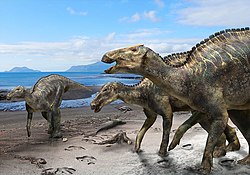 | |
| Kansaignathus | 2021 | Ialovachsk Formation (അന്ത്യ ക്രിറ്റേഷ്യസ്, Santonian) | The first non-avian dinosaur described from Tajikistan |  | |
| Kazaklambia | 2013 | Dabrazhin Formation (അന്ത്യ ക്രിറ്റേഷ്യസ്, Santonian) | Morphologically distinct from other Eurasian lambeosaurines[69] |  | |
| Kelmayisaurus | 1973 | Lianmuqin Formation (തുടക്ക ക്രിറ്റേഷ്യസ്, Valanginian to Albian) | One popular book mentions a giant species belonging to this genus,[70] but this referral may be incorrect |  | |
| Kerberosaurus | 2004 | Tsagayan Formation (അന്ത്യ ക്രിറ്റേഷ്യസ്, Maastrichtian) | Potentially a close relative of Edmontosaurus[71] | ||
| Khaan | 2001 | Djadochta Formation (അന്ത്യ ക്രിറ്റേഷ്യസ്, Campanian) | Two morphotypes of chevrons are known, which may be a sexually dimorphic trait[72] |  | |
| Khulsanurus | 2021 | Barun Goyot Formation (അന്ത്യ ക്രിറ്റേഷ്യസ്, Campanian) | Contemporary with Parvicursor but can be distinguished by characters of its caudal vertebrae[73] | ||
| Kileskus | 2010 | Itat Formation (മധ്യ ട്രയാസ്സിക്, Bathonian) | Uncertain if it possesses the head crest as seen in other proceratosaurids |  | |
| Kinnareemimus | 2009 | Sao Khua Formation (തുടക്ക ക്രിറ്റേഷ്യസ്, Valanginian to Hauterivian) | Potentially one of the oldest ornithomimosaurs |  | |
| Klamelisaurus | 1993 | Shishugou Formation (മധ്യ ട്രയാസ്സിക്, Callovian) | Close relatives included several referred species of Mamenchisaurus[74] |  | |
| കോൽ | 2009 | Djadochta Formation (അന്ത്യ ക്രിറ്റേഷ്യസ്, Campanian) | Had a "hyperarctometatarsus" more strongly pinched than other arctometatarsalian taxa. Described as an alvarezsaurid[75] but has been suggested to be related to Avimimus[76] | ||
| Koreaceratops | 2011 | Sihwa Formation (തുടക്ക ക്രിറ്റേഷ്യസ്, Albian) | Possessed elongated neural spines on its caudal vertebrae. Its describers suggest that it was used as a swimming organ,[77] but a later study found it to live in a semiarid environment, making this unlikely[78] |  | |
| Koreanosaurus | 2011 | Seonso Conglomerate (അന്ത്യ ക്രിറ്റേഷ്യസ്, Campanian) | Had short but powerful forelimbs suggesting it may have been a quadruped[79] |  | |
| Koshisaurus | 2015 | Kitadani Formation (തുടക്ക ക്രിറ്റേഷ്യസ്, Barremian) | Distinguished from other hadrosauroids by the presence of an antorbital fossa |  | |
| Kulceratops | 1995 | Khodzhakul Formation (തുടക്ക ക്രിറ്റേഷ്യസ്, Albian) | Only known from fragments of a jaw and teeth |  | |
| Kulindadromeus | 2014 | Ukureyskaya Formation (മധ്യ ട്രയാസ്സിക്, Bathonian) | An ornithischian that preserves evidence of filaments, suggesting that protofeathers were basal to Dinosauria as a whole |  | |
| Kundurosaurus | 2012 | Udurchukan Formation (അന്ത്യ ക്രിറ്റേഷ്യസ്, Maastrichtian) | May be synonymous with Kerberosaurus[80] |  | |
| Kuru | 2021 | Barun Goyot Formation (അന്ത്യ ക്രിറ്റേഷ്യസ്, Maastrichtian) | Had been informally referred to as "Airakoraptor" prior to its formal description |  | |
| Laiyangosaurus | 2019 | Wangshi Group (അന്ത്യ ക്രിറ്റേഷ്യസ്, Maastrichtian) | Some specimens referred to this edmontosaurin actually belong to kritosaurins and lambeosaurines[81] |  | |
| Lanzhousaurus | 2005 | Hekou Group (തുടക്ക ക്രിറ്റേഷ്യസ്, Barremian) | Possessed the largest known teeth of any dinosaur |  | |
| Leshansaurus | 2009 | Shaximiao Formation (അന്ത്യ ട്രയാസ്സിക്, Oxfordian to Kimmeridgian) | Its braincase is nearly identical to that of Piveteausaurus[82] |  | |
| Levnesovia | 2009 | Bissekty Formation (അന്ത്യ ക്രിറ്റേഷ്യസ്, Turonian) | One of the smallest known hadrosauroids[42] | ||
| Liaoceratops | 2002 | Yixian Formation (തുടക്ക ക്രിറ്റേഷ്യസ്, Barremian) | One specimen was found without a skull roof, possibly displaced by a predator to eat its brain[83] | 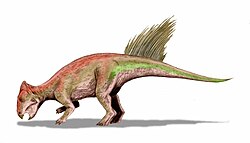 | |
| Liaoningosaurus | 2001 | Yixian Formation (തുടക്ക ക്രിറ്റേഷ്യസ്, Aptian) | One specimen has been interpreted as possessing fork-like teeth, sharp claws, and stomach contents including fish, which has been claimed to be evidence of a semi-aquatic, turtle-like lifestyle[84] |  | |
| Liaoningotitan | 2018 | Yixian Formation (തുടക്ക ക്രിറ്റേഷ്യസ്, Barremian) | The second sauropod named from the Yixian Formation | ||
| Liaoningvenator | 2017 | Yixian Formation (തുടക്ക ക്രിറ്റേഷ്യസ്, Barremian) | Uniquely preserved with the head curving forwards, differing from the classic theropod "death pose" and the sleeping position of other troodontids |  | |
| Limusaurus | 2009 | Shishugou Formation (അന്ത്യ ട്രയാസ്സിക്, Oxfordian) | Multiple specimens from different growth stages are known. Juveniles possessed teeth which were lost and replaced with a beak as adults, suggesting a change in diet[85] |  | |
| Lingwulong | 2018 | Yanan Formation?/Zhiluo Formation? (മധ്യ ട്രയാസ്സിക് to അന്ത്യ ട്രയാസ്സിക്, Aalenian to Oxfordian) | The first confirmed diplodocoid from Asia. Originally considered Early Jurassic, making it the oldest known neosauropod, but this age has been disputed[86][87] |  | |
| Lingyuanosaurus | 2019 | Jiufotang Formation?/Yixian Formation? (തുടക്ക ക്രിറ്റേഷ്യസ്, Valanginian to Aptian) | Possessed a mix of basal and derived therizinosaurian traits |  | |
| Linhenykus | 2011 | Bayan Mandahu Formation (അന്ത്യ ക്രിറ്റേഷ്യസ്, Campanian) | Completely monodactyl due to lacking the vestigial second and third fingers of other alvarezsaurids |  | |
| Linheraptor | 2010 | Bayan Mandahu Formation (അന്ത്യ ക്രിറ്റേഷ്യസ്, Campanian) | Potentially a synonym of Tsaagan[88] |  | |
| Linhevenator | 2011 | Bayan Mandahu Formation (അന്ത്യ ക്രിറ്റേഷ്യസ്, Campanian) | Had a greatly enlarged sickle claw, comparable in size to those of dromaeosaurids |  | |
| Liubangosaurus | 2010 | Xinlong Formation (തുടക്ക ക്രിറ്റേഷ്യസ്, Barremian to Aptian) | Described only as a eusauropod[89] but has since been reinterpreted as a somphospondylian[90] | ||
| Luanchuanraptor | 2007 | Qiupa Formation (അന്ത്യ ക്രിറ്റേഷ്യസ്, Maastrichtian) | The first Asian dromaeosaurid found outside the Gobi Desert and northeastern China. May have been closely related to Adasaurus[14] |  | |
| Lufengosaurus | 1940 | Lufeng Formation (തുടക്ക ജുറാസ്സിക്, Hettangian to Sinemurian) | The rib of one specimen preserves the oldest known evidence of collagen proteins[91] |  | |
| Luoyanggia | 2009 | Haoling Formation (തുടക്ക ക്രിറ്റേഷ്യസ്, Aptian to Albian) | Originally believed to date from the Late Cretaceous | ||
| Machairasaurus | 2010 | Bayan Mandahu Formation (അന്ത്യ ക്രിറ്റേഷ്യസ്, Campanian) | A potential specimen has been found brooding on its eggs[92] |  | |
| Mahakala | 2007 | Djadochta Formation (അന്ത്യ ക്രിറ്റേഷ്യസ്, Campanian) | Possessed basal traits for a dromaeosaurid. May be a close relative of Halszkaraptor[93] |  | |
| Maleevus | 1987 | Bayan Shireh Formation (അന്ത്യ ക്രിറ്റേഷ്യസ്, Cenomanian to Santonian) | Its only purportedly distinguishing trait is also shared with Pinacosaurus[36] | ||
| Mamenchisaurus | 1954 | Penglaizhen Formation, Shaximiao Formation, Shishugou Formation, Suining Formation (അന്ത്യ ട്രയാസ്സിക് to തുടക്ക ക്രിറ്റേഷ്യസ്, Oxfordian to Aptian) | Several species have been named, but most may not belong to this genus[74] |  | |
| Mandschurosaurus | 1930 | Grès supérieurs Formation?, Yuliangze Formation (അന്ത്യ ക്രിറ്റേഷ്യസ്, Maastrichtian) | One of the first non-avian dinosaurs named from Chinese remains |  | |
| Mei | 2004 | Yixian Formation (തുടക്ക ക്രിറ്റേഷ്യസ്, Aptian) | Two specimens are preserved in bird-like sleeping positions[94] | 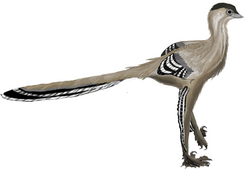 | |
| Microceratus | 2008 | Ulansuhai Formation (അന്ത്യ ക്രിറ്റേഷ്യസ്, Turonian) | Originally named Microceratops, although that genus name is preoccupied by a wasp | ||
| Microhadrosaurus | 1979 | Nanxiong Formation (അന്ത്യ ക്രിറ്റേഷ്യസ്, Maastrichtian) | Reportedly an unusually small hadrosaurid | ||
| Micropachycephalosaurus | 1978 | Wangshi Group (അന്ത്യ ക്രിറ്റേഷ്യസ്, Campanian to Maastrichtian) | Once considered to be a pachycephalosaur, although it is now usually considered to be a ceratopsian[95] |  | |
| Microraptor | 2000 | Jiufotang Formation (തുടക്ക ക്രിറ്റേഷ്യസ്, Aptian) | Known from over three hundred fossils.[96] Several are well-preserved enough to reveal fine details such as feather covering and an iridescent black coloration[97] | 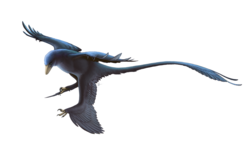 | |
| Minotaurasaurus | 2009 | Djadochta Formation (അന്ത്യ ക്രിറ്റേഷ്യസ്, Campanian) | The holotype skull was excavated illegally, which obscured its true provenance until recently |  | |
| Mongolosaurus | 1933 | On Gong Formation (തുടക്ക ക്രിറ്റേഷ്യസ്, Aptian to Albian) | Known from only scant remains but has been confidently assigned to Somphospondyli in recent years[90] |  | |
| Mongolostegus | 2018 | Dzunbain Formation (തുടക്ക ക്രിറ്റേഷ്യസ്, Aptian to Albian) | Informally assigned to the genus Wuerhosaurus before its formal description |  | |
| Monkonosaurus | 1986 | Loe-ein Formation?/Lura Formation? (അന്ത്യ ട്രയാസ്സിക്, Oxfordian to Kimmeridgian?/തുടക്ക ക്രിറ്റേഷ്യസ്, Albian?) | Poorly known | ||
| Monolophosaurus | 1993 | Shishugou Formation (മധ്യ ട്രയാസ്സിക്, Bathonian to Callovian) | Possessed a short, rectangular crest running along the midline of the skull |  | |
| Mononykus | 1993 | Nemegt Formation (അന്ത്യ ക്രിറ്റേഷ്യസ്, Maastrichtian) | Proposed to have an anteater-like lifestyle, using its unique forearms to break into termite mounds[98] |  | |
| Mosaiceratops | 2015 | Xiaguan Formation (അന്ത്യ ക്രിറ്റേഷ്യസ്, Turonian to Campanian) | Combined features of different groups of basal ceratopsians |  | |
| Nankangia | 2013 | Nanxiong Formation (അന്ത്യ ക്രിറ്റേഷ്യസ്, Maastrichtian) | May have specialized in soft foods such as leaves and seeds[99] |  | |
| Nanningosaurus | 2007 | Unnamed formation (അന്ത്യ ക്രിറ്റേഷ്യസ്, Maastrichtian) | Potentially a basal lambeosaurine | ||
| Nanshiungosaurus | 1979 | Nanxiong Formation (അന്ത്യ ക്രിറ്റേഷ്യസ്, Maastrichtian) | Originally misidentified as a sauropod on account of its unusual pelvis |  | |
| Nanyangosaurus | 2000 | Xiaguan Formation (അന്ത്യ ക്രിറ്റേഷ്യസ്, Turonian to Campanian) | Completely lost the first digit of its hands |  | |
| Napaisaurus | 2022 | Xinlong Formation (തുടക്ക ക്രിറ്റേഷ്യസ്, Aptian to Albian) | May be closely related to contemporary Thai iguanodonts | ||
| Natovenator | 2022 | Barun Goyot Formation (അന്ത്യ ക്രിറ്റേഷ്യസ്, Maastrichtian) | Possessed a streamlined body and a long, toothy snout, convergently similar to aquatic vertebrates |  | |
| Nebulasaurus | 2015 | Zhanghe Formation (മധ്യ ട്രയാസ്സിക്, Aalenian to Bajocian) | Only known from a single braincase, but it is enough to tell that it was related to Spinophorosaurus |  | |
| Neimongosaurus | 2001 | Iren Dabasu Formation (അന്ത്യ ക്രിറ്റേഷ്യസ്, Cenomanian) | Could extend its arms considerably forward due to the structure of its shoulder joint[100] |  | |
| Nemegtomaia | 2005 | Barun Goyot Formation, Nemegt Formation (അന്ത്യ ക്രിറ്റേഷ്യസ്, Campanian to Maastrichtian) | One specimen preserves traces of damage by skin beetles[101] |  | |
| Nemegtonykus | 2019 | Nemegt Formation (അന്ത്യ ക്രിറ്റേഷ്യസ്, Campanian to Maastrichtian) | The second alvarezsaurid named from the Nemegt Formation |  | |
| Nemegtosaurus | 1971 | Nemegt Formation, Subashi Formation? (അന്ത്യ ക്രിറ്റേഷ്യസ്, Maastrichtian) | Had a long, low skull similar in proportions to those of diplodocoids |  | |
| Ningyuansaurus | 2012 | Yixian Formation (തുടക്ക ക്രിറ്റേഷ്യസ്, Aptian) | Preserves small oval-shaped structures in its stomach region which may be seeds | ||
| Nipponosaurus | 1936 | Yezo Group (അന്ത്യ ക്രിറ്റേഷ്യസ്, Santonian to Campanian) | Discovered on the island of Sakhalin, which was owned by Japan in 1936 but later annexed to Russia |  | |
| Oksoko | 2020 | Nemegt Formation (അന്ത്യ ക്രിറ്റേഷ്യസ്, Maastrichtian) | Its third finger was so greatly reduced that it was functionally didactyl |  | |
| Olorotitan | 2003 | Udurchukan Formation (അന്ത്യ ക്രിറ്റേഷ്യസ്, Maastrichtian) | Had a broad, hatchet-shaped crest |  | |
| Omeisaurus | 1939 | Shaximiao Formation (മധ്യ ട്രയാസ്സിക്, Bathonian to Callovian) | Members of this genus are characterized by extremely elongated necks |  | |
| Ondogurvel | 2022 | Barun Goyot Formation (അന്ത്യ ക്രിറ്റേഷ്യസ്, (Campanian) | Known from well-preserved remains of the hands and feet |  | |
| Opisthocoelicaudia | 1977 | Nemegt Formation (അന്ത്യ ക്രിറ്റേഷ്യസ്, Campanian to Maastrichtian) | Walked on its metacarpals due to its complete lack of phalanges |  | |
| Oviraptor | 1924 | Djadochta Formation (അന്ത്യ ക്രിറ്റേഷ്യസ്, Campanian to Maastrichtian) | Originally mistakenly thought to be an egg-eater |  | |
| Pachysuchus | 1951 | Lufeng Formation (തുടക്ക ജുറാസ്സിക്, Sinemurian to Pliensbachian) | Considered a phytosaur from its original naming until a redescription in 2012[102] | ||
| Panguraptor | 2014 | Lufeng Formation (തുടക്ക ജുറാസ്സിക്, Hettangian to Sinemurian) | The first definitive coelophysoid known from Asia | ||
| Papiliovenator | 2021 | Bayan Mandahu Formation (അന്ത്യ ക്രിറ്റേഷ്യസ്, Campanian) | Had a short, subtriangular skull similar to those of Early Cretaceous troodontids |  | |
| Paralitherizinosaurus | 2022 | Yezo Group (അന്ത്യ ക്രിറ്റേഷ്യസ്, Campanian | Had stiffened claws that may have been used to pull vegetation to the mouth[103] |  | |
| Parvicursor | 1996 | Barun Goyot Formation (അന്ത്യ ക്രിറ്റേഷ്യസ്, Campanian) | Originally believed to represent a diminutive adult dinosaur, although it was recently reinterpreted as a juvenile[104] |  | |
| Pedopenna | 2005 | Haifanggou Formation (മധ്യ ട്രയാസ്സിക്, Callovian) | Known from a single leg with the impressions of long, symmetrical feathers |  | |
| Peishansaurus | 1953 | Minhe Formation (അന്ത്യ ക്രിറ്റേഷ്യസ്, Santonian to Campanian) | Has been compared to thyreophorans and marginocephalians, but it is impossible to determine which assignment is correct | ||
| Penelopognathus | 2005 | Bayin-Gobi Formation (തുടക്ക ക്രിറ്റേഷ്യസ്, Albian) | Named from a single dentary | ||
| Phaedrolosaurus | 1973 | Lianmuqin Formation (തുടക്ക ക്രിറ്റേഷ്യസ്, Valanginian to Albian) | May have been a dromaeosaurid[105] | ||
| Philovenator | 2012 | Bayan Mandahu Formation (അന്ത്യ ക്രിറ്റേഷ്യസ്, Campanian) | Closely related to the contemporary Linhevenator[94] but likely represents a separate taxon[106] |  | |
| Phuwiangosaurus | 1994 | Sao Khua Formation (തുടക്ക ക്രിറ്റേഷ്യസ്, Valanginian to Hauterivian) | A large member of the Euhelopodidae[90] |  | |
| Phuwiangvenator | 2019 | Sao Khua Formation) (തുടക്ക ക്രിറ്റേഷ്യസ്, Barremian) | Combines features of both allosauroids and coelurosaurs[107] | ||
| Pinacosaurus | 1933 | Bayan Mandahu Formation, Djadochta Formation (അന്ത്യ ക്രിറ്റേഷ്യസ്, Santonian to Campanian) | Possessed an enlarged hyoid that may indicate a feeding specialization such as fruit-eating or anteater-like insectivory[108] |  | |
| Plesiohadros | 2014 | Alagteeg Formation (അന്ത്യ ക്രിറ്റേഷ്യസ്, Campanian) | The first hadrosauroid known from the Alagteeg Formation | ||
| Prenocephale | 1974 | Nemegt Formation (അന്ത്യ ക്രിറ്റേഷ്യസ്, Maastrichtian) | Had a distinctively conical dome |  | |
| Probactrosaurus | 1966 | Dashuigou Formation (അന്ത്യ ക്രിറ്റേഷ്യസ്, Cenomanian to Coniacian) | The closest relative to the Hadrosauromorpha based on the definition of the group[109] |  | |
| Prodeinodon | 1924 | Öösh Formation, Xinlong Formation (തുടക്ക ക്രിറ്റേഷ്യസ്, Barremian to Aptian) | Potentially a carnosaur[110] | ||
| Protarchaeopteryx | 1997 | Yixian Formation (തുടക്ക ക്രിറ്റേഷ്യസ്, Aptian) | Usually thought to be a basal oviraptorosaur but one study suggests a basal position within Pennaraptora[14] |  | |
| Protoceratops | 1923 | Bayan Mandahu Formation, Djadochta Formation (അന്ത്യ ക്രിറ്റേഷ്യസ്, Campanian) | Its remains are so abundant that it has been nicknamed the "sheep of the Cretaceous" |  | |
| Protognathosaurus | 1991 | Shaximiao Formation (മധ്യ ട്രയാസ്സിക്, Bathonian to Callovian) | Originally named Protognathus, but that is preoccupied by an extinct beetle[111] | ||
| Psittacosaurus | 1923 | Andakhuduk Formation, Bayin-Gobi Formation, Ejinhoro Formation, Ilek Formation, Jiufotang Formation, Khok Kruat Formation, Öösh Formation, Qingshan Formation, Tugulu Group, Xinminbao Group, Yixian Formation (തുടക്ക ക്രിറ്റേഷ്യസ്, Barremian to Albian) | Known from hundreds of specimens, many of them well-preserved. Lived in a broad range |  | |
| Pukyongosaurus | 2001 | Hasandong Formation (തുടക്ക ക്രിറ്റേഷ്യസ്, Aptian to Albian) | One of its caudal vertebrae has bite marks caused by theropod teeth |  | |
| Qianzhousaurus | 2014 | Nanxiong Formation (അന്ത്യ ക്രിറ്റേഷ്യസ്, Maastrichtian) | Has been nicknamed "Pinocchio rex" on account of its elongated snout | 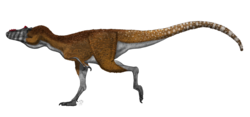 | |
| Qiaowanlong | 2009 | Xinminbao Group (തുടക്ക ക്രിറ്റേഷ്യസ്, Albian) | Originally described as a brachiosaurid[112] but has since been reinterpreted as a euhelopodid[113] |  | |
| Qijianglong | 2015 | Suining Formation (തുടക്ക ക്രിറ്റേഷ്യസ്, Aptian) | Once believed to date from the Late Jurassic | ||
| Qingxiusaurus | 2008 | Unnamed formation (അന്ത്യ ക്രിറ്റേഷ്യസ്, Maastrichtian) | Known from very limited remains | ||
| Qinlingosaurus | 1996 | Hongtuling Formation?/Shanyang Formation? (അന്ത്യ ക്രിറ്റേഷ്യസ്, Maastrichtian) | Potentially a titanosaur given its age, but this cannot be confirmed |  | |
| Qiupalong | 2011 | Qiupa Formation (അന്ത്യ ക്രിറ്റേഷ്യസ്, Campanian to Maastrichtian) | A referred specimen was found in Canada[114] |  | |
| Qiupanykus | 2018 | Qiupa Formation (അന്ത്യ ക്രിറ്റേഷ്യസ്, Maastrichtian) | May have used its robust thumb claws to crack open oviraptorid eggshells[115] | ||
| Quaesitosaurus | 1983 | Barun Goyot Formation (അന്ത്യ ക്രിറ്റേഷ്യസ്, Maastrichtian} | Potentially a close relative of Nemegtosaurus |  | |
| Ratchasimasaurus | 2011 | Khok Kruat Formation (തുടക്ക ക്രിറ്റേഷ്യസ്, Aptian) | Only known from a single toothless dentary |  | |
| Rhomaleopakhus | 2021 | Kalaza Formation (അന്ത്യ ട്രയാസ്സിക്, Tithonian) | Possessed a robust forelimb that may be a locomotory adaptation | ||
| Rinchenia | 1997 | Nemegt Formation (അന്ത്യ ക്രിറ്റേഷ്യസ്, Maastrichtian) | Had a tall, domed crest |  | |
| Ruixinia | 2022 | Yixian Formation (തുടക്ക ക്രിറ്റേഷ്യസ്, Barremian) | Its last few caudal vertebrae were fused | ||
| Ruyangosaurus | 2009 | Haoling Formation (തുടക്ക ക്രിറ്റേഷ്യസ്, Aptian to Albian) | Only known from scant remains but was one of the largest dinosaurs known from Asia |  | |
| Sahaliyania | 2008 | Yuliangze Formation (അന്ത്യ ക്രിറ്റേഷ്യസ്, Maastrichtian) | Possibly a synonym of Amurosaurus[116] |  | |
| Saichania | 1977 | Barun Goyot Formation, Nemegt Formation (അന്ത്യ ക്രിറ്റേഷ്യസ്, Campanian to Maastrichtian) | Possessed complicated nasal passages that may have cooled the air it breathed |  | |
| Sanpasaurus | 1944 | Ziliujing Formation (തുടക്ക ജുറാസ്സിക്, Pliensbachian) | Historically conflated with the remains of an ornithischian |  | |
| Sanxiasaurus | 2019 | Xintiangou Formation (മധ്യ ട്രയാസ്സിക്, Bajocian) | The oldest neornithischian known from Asia | ||
| Saurolophus | 1912 | Nemegt Formation (അന്ത്യ ക്രിറ്റേഷ്യസ്, Maastrichtian) | Type species was found in Canada. The Asian species is distinguished by its larger size and backwards-pointing diagonal crest |  | |
| Sauroplites | 1953 | Zhidan Group (തുടക്ക ക്രിറ്റേഷ്യസ്, Barremian to Aptian) | Preserved lying on its back with parts of its armor in an articulated position | ||
| Saurornithoides | 1924 | Djadochta Formation (അന്ത്യ ക്രിറ്റേഷ്യസ്, Campanian) | Its hindlimbs were well-developed even as juveniles, suggesting it needed little to no parental care |  | |
| Scansoriopteryx | 2002 | Haifanggou Formation (മധ്യ ട്രയാസ്സിക് to അന്ത്യ ട്രയാസ്സിക്, Callovian to Kimmeridgian) | Was well-adapted for climbing due to the structure of its hands and feet |  | |
| Segnosaurus | 1979 | Bayan Shireh Formation (അന്ത്യ ക്രിറ്റേഷ്യസ്, Cenomanian to Turonian) | One of the first known therizinosaurs. Its relationships were originally obscure |  | |
| Serikornis | 2017 | Tiaojishan Formation (മധ്യ ട്രയാസ്സിക് to അന്ത്യ ട്രയാസ്സിക്, Callovian to Oxfordian) | Possessed simple, wispy feathers similar to those of a Silkie chicken |  | |
| Shamosaurus | 1983 | Dzunbain Formation (തുടക്ക ക്രിറ്റേഷ്യസ്, Aptian to Albian) | The osteoderms on its head were not separated into obvious tiles as with later ankylosaurs | ||
| Shanag | 2007 | Öösh Formation (തുടക്ക ക്രിറ്റേഷ്യസ്, Berriasian to Barremian) | Shows a mixture of traits of various paravian groups |  | |
| Shantungosaurus | 1973 | Wangshi Group (അന്ത്യ ക്രിറ്റേഷ്യസ്, Campanian) | The largest known hadrosaurid |  | |
| Shanxia | 1998 | Huiquanpu Formation (അന്ത്യ ക്രിറ്റേഷ്യസ്, Cenomanian to Campanian) | May be synonymous with Tianzhenosaurus[117] and/or Saichania[36] | ||
| Shanyangosaurus | 1996 | Shanyang Formation (അന്ത്യ ക്രിറ്റേഷ്യസ്, Maastrichtian) | Indeterminate but its hollow bones are a synapomorphy for Coelurosauria. One study suggests an oviraptorosaurian position[14] | ||
| Shaochilong | 2009 | Ulansuhai Formation (അന്ത്യ ക്രിറ്റേഷ്യസ്, Cenomanian to Turonian) | Had a relatively short maxilla, suggesting a unique ecological role |  | |
| Shenzhousaurus | 2003 | Yixian Formation (തുടക്ക ക്രിറ്റേഷ്യസ്, Aptian) | Preserves pebbles in its thoracic cavity which may be gastroliths |  | |
| Shidaisaurus | 2009 | Chuanjie Formation (മധ്യ ട്രയാസ്സിക്, Aalenian) | Potentially one of the oldest known allosauroids | ||
| Shishugounykus | 2019 | Shishugou Formation (അന്ത്യ ട്രയാസ്സിക്, Oxfordian) | Its manus combines features of both alvarezsaurians and more basal coelurosaurs |  | |
| Shixinggia | 2005 | Pingling Formation (അന്ത്യ ക്രിറ്റേഷ്യസ്, Maastrichtian) | Known from a fair amount of postcranial material | ||
| Shri | 2021 | Barun Goyot Formation (അന്ത്യ ക്രിറ്റേഷ്യസ്, Maastrichtian) | Before its formal description, it was nicknamed "Ichabodcraniosaurus" because its holotype lacked a skull |  | |
| Shuangmiaosaurus | 2003 | Sunjiawan Formation (തുടക്ക ക്രിറ്റേഷ്യസ്, Albian) | Only known from some parts of a skull | ||
| Shunosaurus | 1983 | Shaximiao Formation (അന്ത്യ ട്രയാസ്സിക്, Oxfordian to Kimmeridgian) | Possessed a small tail club topped by two short spikes |  | |
| Shuvuuia | 1998 | Djadochta Formation (അന്ത്യ ക്രിറ്റേഷ്യസ്, Campanian) | Displays several adaptations that may point to a nocturnal, owl-like lifestyle[118] |  | |
| Siamodon | 2011 | Khok Kruat Formation (തുടക്ക ക്രിറ്റേഷ്യസ്, Aptian) | May have been closely related to Probactrosaurus[119] |  | |
| Siamosaurus | 1986 | Khok Kruat Formation, Sao Khua Formation (തുടക്ക ക്രിറ്റേഷ്യസ്, Barremian to Aptian) | Only known from teeth. Some spinosaurid postcrania from the same area may be referrable to this genus[120] |  | |
| Siamotyrannus | 1996 | Sao Khua Formation (തുടക്ക ക്രിറ്റേഷ്യസ്, Berriasian to Barremian) | Has been recovered in a variety of positions within Avetheropoda |  | |
| Siamraptor | 2019 | Khok Kruat Formation (തുടക്ക ക്രിറ്റേഷ്യസ്, Aptian) | The oldest carcharodontosaurian known from Southeast Asia |  | |
| Sibirotitan | 2017 | Ilek Formation (തുടക്ക ക്രിറ്റേഷ്യസ്, Barremian) | Its sacral ribs are star-shaped in dorsal view |  | |
| Siluosaurus | 1997 | Xinminbao Group (തുടക്ക ക്രിറ്റേഷ്യസ്, Barremian to Albian) | Possessed the smallest known teeth of any ornithopod | ||
| Silutitan | 2021 | Shengjinkou Formation (തുടക്ക ക്രിറ്റേഷ്യസ്, Aptian) | Known from six cervical vertebrae associated with a pterosaur jaw |  | |
| Similicaudipteryx | 2008 | Jiufotang Formation (തുടക്ക ക്രിറ്റേഷ്യസ്, Aptian to Albian) | Had a short tail ending with a dagger-shaped pygostyle |  | |
| Sinankylosaurus | 2020 | Wangshi Group (അന്ത്യ ക്രിറ്റേഷ്യസ്, Campanian) | Only known from an ilium. Described as an ankylosaur but a recent study doubts this interpretation[121] | ||
| Sinocalliopteryx | 2007 | Yixian Formation (തുടക്ക ക്രിറ്റേഷ്യസ്, Barremian to Aptian) | Stomach contents indicate a possible preference for volant prey such as dromaeosaurids and early birds[122] |  | |
| Sinocephale | 2021 | Ulansuhai Formation (അന്ത്യ ക്രിറ്റേഷ്യസ്, Turonian) | Originally named as a species of Troodon when that genus was thought to be a pachycephalosaur | ||
| Sinoceratops | 2010 | Wangshi Group (അന്ത്യ ക്രിറ്റേഷ്യസ്, Campanian to Maastrichtian) | Possessed forward-curving hornlets and a series of low knobs on the top of the frill |  | |
| Sinocoelurus | 1942 | Kuangyuan Series (അന്ത്യ ട്രയാസ്സിക്, Oxfordian to Tithonian | One study considered it to be a potential plesiosaur[123] |  | |
| Sinornithoides | 1993 | Ejinhoro Formation (തുടക്ക ക്രിറ്റേഷ്യസ്, Aptian to Albian) | Preserved in a roosting position, its head tucked underneath its left wing |  | |
| Sinornithomimus | 2003 | Ulansuhai Formation (അന്ത്യ ക്രിറ്റേഷ്യസ്, Turonian) | Formed age-segregated herds as evidenced by a concentration of juvenile skeletons[124] |  | |
| Sinornithosaurus | 1999 | Yixian Formation (തുടക്ക ക്രിറ്റേഷ്യസ്, Barremian to Aptian) | One specimen has disloged teeth, leading to suggestions it was venomous[125] |  | |
| Sinosauropteryx | 1996 | Yixian Formation (തുടക്ക ക്രിറ്റേഷ്യസ്, Aptian) | The first non-avian dinosaur found with direct evidence of feathers. Analysis of melanosomes suggest it had orange-brown and white countershading with a striped tail and a "bandit mask" around its eyes[126] |  | |
| Sinosaurus | 1940 | Lufeng Formation (തുടക്ക ജുറാസ്സിക്, Hettangian to Sinemurian) | Had a pair of midline crests similar to Dilophosaurus |  | |
| Sinotyrannus | 2009 | Jiufotang Formation (തുടക്ക ക്രിറ്റേഷ്യസ്, Aptian) | One of the earliest known large tyrannosauroids. Closely related to smaller forms such as Proceratosaurus and Guanlong |  | |
| Sinovenator | 2002 | Yixian Formation (തുടക്ക ക്രിറ്റേഷ്യസ്, Barremian) | Some specimens are preserved three-dimensionally |  | |
| Sinraptor | 1993 | Shishugou Formation (അന്ത്യ ട്രയാസ്സിക്, Oxfordian) | May have used its teeth like blades to inflict deep wounds in prey |  | |
| Sinusonasus | 2004 | Yixian Formation (തുടക്ക ക്രിറ്റേഷ്യസ്, Hauterivian) | Had distinctive sinusoid nasal bones |  | |
| Sirindhorna | 2015 | Khok Kruat Formation (തുടക്ക ക്രിറ്റേഷ്യസ്, Aptian) | Its fossils were discovered by corn farmers while digging a reservoir |  | |
| Sonidosaurus | 2006 | Iren Dabasu Formation (അന്ത്യ ക്രിറ്റേഷ്യസ്, Cenomanian to Campanian) | One of the smallest known titanosaurs |  | |
| Stegosaurides | 1953 | Xinminbao Group (തുടക്ക ക്രിറ്റേഷ്യസ്, Hauterivian to Albian) | A thyreophoran of uncertain phylogenetic position | ||
| Suzhousaurus | 2007 | Xinminbao Group (തുടക്ക ക്രിറ്റേഷ്യസ്, Barremian to Aptian) | One of the largest Early Cretaceous therizinosaurs |  | |
| Szechuanosaurus | 1942 | Shaximiao Formation (അന്ത്യ ട്രയാസ്സിക്, Oxfordian to Tithonian) | Only known from teeth and possibly a very fragmentary skeleton |  | |
| Talarurus | 1952 | Bayan Shireh Formation (അന്ത്യ ക്രിറ്റേഷ്യസ്, Cenomanian to Santonian) | Its tail club has been compared to a wicker basket |  | |
| Tambatitanis | 2014 | Sasayama Group (തുടക്ക ക്രിറ്റേഷ്യസ്, Albian) | Possessed disproportionately large chevrons |  | |
| Tangvayosaurus | 1999 | Grès supérieurs Formation (തുടക്ക ക്രിറ്റേഷ്യസ്, Aptian to Albian) | Closely related to Phuwiangosaurus |  | |
| Tanius | 1929 | Wangshi Group (അന്ത്യ ക്രിറ്റേഷ്യസ്, Campanian to Maastrichtian) | Today known from only a few bones; more fossils were once present but were not collected |  | |
| Taohelong | 2013 | Hekou Group (തുടക്ക ക്രിറ്റേഷ്യസ്, Albian) | Possessed a sacral shield similar to that of Polacanthus | ||
| Tarbosaurus | 1955 | Nemegt Formation, Subashi Formation (അന്ത്യ ക്രിറ്റേഷ്യസ്, Maastrichtian) | An apex predator that hunted large prey. Very similar to Tyrannosaurus |  | |
| Tarchia | 1977 | Barun Goyot Formation, Nemegt Formation (അന്ത്യ ക്രിറ്റേഷ്യസ്, Campanian to Maastrichtian) | One specimen preserves injuries to its ribs and tail, possibly from a fight with a member of its own kind[127] |  | |
| Tatisaurus | 1965 | Lufeng Formation (തുടക്ക ജുറാസ്സിക്, Sinemurian) | Potentially a basal thyreophoran |  | |
| Tengrisaurus | 2017 | Murtoi Formation (തുടക്ക ക്രിറ്റേഷ്യസ്, Barremian to Aptian) | Closely related to South American titanosaurs | ||
| Therizinosaurus | 1954 | Nemegt Formation (അന്ത്യ ക്രിറ്റേഷ്യസ്, Maastrichtian) | Possessed extremely elongated and stiffened hand claws |  | |
| Tianchisaurus | 1993 | Toutunhe Formation (അന്ത്യ ട്രയാസ്സിക്, Oxfordian to Kimmeridgian) | Its description uses the spellings Tianchisaurus and Tianchiasaurus interchangeably, but the former is correct[128] | ||
| Tianyulong | 2009 | Tiaojishan Formation (അന്ത്യ ട്രയാസ്സിക്, Oxfordian) | Preserves impressions of long bristles down its back, tail and neck |  | |
| Tianyuraptor | 2009 | Yixian Formation (തുടക്ക ക്രിറ്റേഷ്യസ്, Barremian to Aptian) | Combines features of both northern and southern dromaeosaurids. Had unusual proportions |  | |
| Tianzhenosaurus | 1998 | Huiquanpu Formation (അന്ത്യ ക്രിറ്റേഷ്യസ്, Cenomanian to Campanian) | May be synonymous with Saichania[36] |  | |
| Tienshanosaurus | 1937 | Shishugou Formation (അന്ത്യ ട്രയാസ്സിക്, Oxfordian) | Large but basal for a mamenchisaurid[74] |  | |
| Timurlengia | 2016 | Bissekty Formation (അന്ത്യ ക്രിറ്റേഷ്യസ്, Turonian) | Its inner ear was specialized for detecting low-frequency sounds[129] |  | |
| Tochisaurus | 1991 | Nemegt Formation (അന്ത്യ ക്രിറ്റേഷ്യസ്, Maastrichtian) | Known from only a single metatarsus |  | |
| Tonganosaurus | 2010 | Yimen Formation (തുടക്ക ജുറാസ്സിക്, Pliensbachian) | Potentially the oldest known mamenchisaurid | ||
| Tongtianlong | 2016 | Nanxiong Formation (അന്ത്യ ക്രിറ്റേഷ്യസ്, Maastrichtian) | The pose of the holotype suggests it died while trying to free itself from mud |  | |
| Tsaagan | 2006 | Djadochta Formation (അന്ത്യ ക്രിറ്റേഷ്യസ്, Campanian) | Very similar to Velociraptor but differs in some features of the skull[130] |  | |
| Tsagantegia | 1993 | Bayan Shireh Formation (അന്ത്യ ക്രിറ്റേഷ്യസ്, Cenomanian to Santonian) | Had a long, shovel-shaped snout which may indicate a browsing lifestyle[131] |  | |
| Tsintaosaurus | 1958 | Wangshi Group (അന്ത്യ ക്രിറ്റേഷ്യസ്, Campanian) | Originally mistakenly believed to have possessed a unicorn horn-like crest |  | |
| Tugulusaurus | 1973 | Lianmuqin Formation (തുടക്ക ക്രിറ്റേഷ്യസ്, Barremian to Albian) | Potentially an early, Xiyunykus-grade alvarezsaurian[132] | ||
| Tuojiangosaurus | 1977 | Shaximiao Formation (അന്ത്യ ട്രയാസ്സിക്, Oxfordian to Kimmeridgian) | Possessed two rows of tall, pointed plates, thickened in the center as if they were modified spikes |  | |
| Turanoceratops | 1989 | Bissekty Formation (അന്ത്യ ക്രിറ്റേഷ്യസ്, Turonian) | Had a pair of brow horns like ceratopsids but was likely not a member of that family |  | |
| Tylocephale | 1974 | Barun Goyot Formation (അന്ത്യ ക്രിറ്റേഷ്യസ്, Campanian) | Only known from a partial skull but it is enough to tell that it had a remarkably tall dome |  | |
| Udanoceratops | 1992 | Djadochta Formation (അന്ത്യ ക്രിറ്റേഷ്യസ്, Campanian) | The largest known leptoceratopsid |  | |
| Ultrasaurus | 1983 | Gugyedong Formation (തുടക്ക ക്രിറ്റേഷ്യസ്, Aptian to Albian) | Described as very large but this may be due to misidentification of a bone | ||
| Ulughbegsaurus | 2021 | Bissekty Formation (അന്ത്യ ക്രിറ്റേഷ്യസ്, Turonian) | Known from only a maxilla. Originally described as a late-surviving carnosaur but may in fact be a large-bodied dromaeosaurid[133] | ||
| Urbacodon | 2007 | Bissekty Formation, Dzharakuduk Formation (അന്ത്യ ക്രിറ്റേഷ്യസ്, Cenomanian to Turonian) | The holotype preserves a gap separating the eight rear teeth from the rest of its teeth | ||
| Vayuraptor | 2019 | Sao Khua Formation (തുടക്ക ക്രിറ്റേഷ്യസ്, Barremian) | Potentially ancestral to megaraptorans[134] or an early member of the group[135] | ||
| Velociraptor | 1924 | Bayan Mandahu Formation, Djadochta Formation (അന്ത്യ ക്രിറ്റേഷ്യസ്, Campanian) | One ulna preserves quill knobs[136] |  | |
| Wakinosaurus | 1992 | Sengoku Formation (തുടക്ക ക്രിറ്റേഷ്യസ്, Valanginian to Barremian) | May be a close relative of Acrocanthosaurus[110] | ||
| Wannanosaurus | 1977 | Xiaoyan Formation (അന്ത്യ ക്രിറ്റേഷ്യസ്, Maastrichtian) | Basal for a pachycephalosaur as indicated by its flat skull with large openings |  | |
| Wuerhosaurus | 1973 | Ejinhoro Formation, Tugulu Group (തുടക്ക ക്രിറ്റേഷ്യസ്, Hauterivian) | One of the last and largest known stegosaurs. Preserved with low rectangular plates but these may be broken |  | |
| Wulagasaurus | 2008 | Yuliangze Formation (അന്ത്യ ക്രിറ്റേഷ്യസ്, Maastrichtian) | A rare hadrosaurid known from far less remains than the contemporary Sahaliyania |  | |
| Wulatelong | 2013 | Bayan Mandahu Formation (അന്ത്യ ക്രിറ്റേഷ്യസ്, Campanian) | Known from a partial skeleton including some parts of the skull |  | |
| Wulong | 2020 | Jiufotang Formation (തുടക്ക ക്രിറ്റേഷ്യസ്, Aptian) | Possessed an extremely long tail tipped by two long feathers |  | |
| Xianshanosaurus | 2009 | Haoling Formation (തുടക്ക ക്രിറ്റേഷ്യസ്, Albian) | May have been closely related to Daxiatitan[90] |  | |
| Xiaosaurus | 1983 | Shaximiao Formation (മധ്യ ട്രയാസ്സിക്, Bajocian to Callovian) | An ornithischian of uncertain affinities | ||
| Xiaotingia | 2011 | Tiaojishan Formation (മധ്യ ട്രയാസ്സിക് to അന്ത്യ ട്രയാസ്സിക്, Bathonian to Oxfordian) | Well-preserved but inconsistent in phylogenetic placement. Some studies suggest a position as an early avialan[137] |  | |
| Xingtianosaurus | 2019 | Yixian Formation (തുടക്ക ക്രിറ്റേഷ്യസ്, Barremian) | Retained the large third finger that was lost in other caudipterids |  | |
| Xingxiulong | 2017 | Lufeng Formation (തുടക്ക ജുറാസ്സിക്, Hettangian | Possessed a robust scapula which increased forelimb mobility for feeding |  | |
| Xinjiangovenator | 2005 | Lianmuqin Formation (തുടക്ക ക്രിറ്റേഷ്യസ്, Valanginian to Albian) | Remains originally identified as Phaedrolosaurus |  | |
| Xinjiangtitan | 2013 | Qiketai Formation (മധ്യ ട്രയാസ്സിക്, Callovian) | Had an extremely long neck |  | |
| Xiongguanlong | 2009 | Xinminbao Group, (തുടക്ക ക്രിറ്റേഷ്യസ്, Aptian) | More robust than other early tyrannosauroids, possibly to support its elongated skull |  | |
| Xixianykus | 2010 | Majiacun Formation (അന്ത്യ ക്രിറ്റേഷ്യസ്, Santonian to Coniacian) | One of the smallest known non-avian dinosaurs |  | |
| Xixiasaurus | 2010 | Majiacun Formation (അന്ത്യ ക്രിറ്റേഷ്യസ്, Coniacian to Campanian) | Distinguished from other troodontids by its possession of exactly twenty-two teeth in each maxilla |  | |
| Xixiposaurus | 2010 | Lufeng Formation (തുടക്ക ജുറാസ്സിക്, Hettangian to Pliensbachian) | Poorly known | ||
| Xiyunykus | 2018 | Tugulu Group (തുടക്ക ക്രിറ്റേഷ്യസ്, Barremian to Aptian) | Had an unspecialized hand morphology for an alvarezsaur, having three fingers of roughly equal length and construction |  | |
| Xuanhanosaurus | 1984 | Shaximiao Formation (മധ്യ ട്രയാസ്സിക് to അന്ത്യ ട്രയാസ്സിക്, Bathonian to Callovian to Oxfordian) | Originally mistakenly believed to have been capable of quadrupedal locomotion |  | |
| Xuanhuaceratops | 2006 | Houcheng Formation (അന്ത്യ ട്രയാസ്സിക്, Tithonian) | Possessed a large premaxillary tooth right behind its beak |  | |
| Xunmenglong | 2019 | Huajiying Formation (തുടക്ക ക്രിറ്റേഷ്യസ്, Hauterivian) | The holotype was originally presented as part of a chimera involving three different animals[138] |  | |
| Xuwulong | 2011 | Xinminbao Group (തുടക്ക ക്രിറ്റേഷ്യസ്, Aptian to Albian) | The tip of its dentary was V-shaped when viewed from the side |  | |
| Yamaceratops | 2006 | Javkhlant Formation (അന്ത്യ ക്രിറ്റേഷ്യസ്, Santonian) | Possessed a short, stubby frill |  | |
| Yamatosaurus | 2021 | Kita-Ama Formation (അന്ത്യ ക്രിറ്റേഷ്യസ്, Maastrichtian) | Basal yet survived late enough to be contemporaneous with more advanced hadrosaurids |  | |
| Yandusaurus | 1979 | Shaximiao Formation (മധ്യ ട്രയാസ്സിക്, Bathonian) | Some fossils were destroyed by a composter before they could be studied[139] | ||
| Yangchuanosaurus | 1978 | Shaximiao Formation (മധ്യ ട്രയാസ്സിക് to അന്ത്യ ട്രയാസ്സിക്, Bathonian to Oxfordian) | The largest theropod known from the Shaximiao |  | |
| Yi | 2015 | Tiaojishan Formation (മധ്യ ട്രയാസ്സിക് to അന്ത്യ ട്രയാസ്സിക്, Callovian to Oxfordian) | Possessed a "styliform element" jutting out from its wrist that supported a bat-like membranous wing | 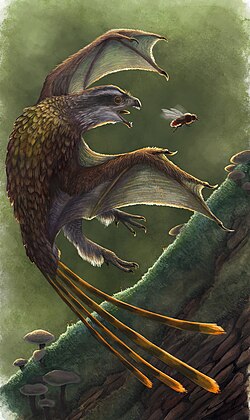 | |
| Yimenosaurus | 1990 | Fengjiahe Formation (തുടക്ക ജുറാസ്സിക്, Pliensbachian) | Much of its skeleton is known, including the entirety of the skull |  | |
| Yingshanosaurus | 1994 | Shaximiao Formation (അന്ത്യ ട്രയാസ്സിക്, Kimmeridgian) | Possessed greatly enlarged shoulder spines | ||
| Yinlong | 2006 | Shishugou Formation (അന്ത്യ ട്രയാസ്സിക്, Oxfordian) | Its skull displays features of ceratopsians, pachycephalosaurs, and heterodontosaurids |  | |
| Yixianosaurus | 2003 | Yixian Formation (തുടക്ക ക്രിറ്റേഷ്യസ്, Aptian) | Inconsistent in phylogenetic placement. Had extremely elongated manual elements |  | |
| Yizhousaurus | 2018 | Fengjiahe Formation (തുടക്ക ജുറാസ്സിക്, Sinemurian) | Its skull was very similar to those of sauropods, despite being more primitive |  | |
| Yongjinglong | 2014 | Hekou Group (തുടക്ക ക്രിറ്റേഷ്യസ്, Albian) | Possessed an extremely long, broad scapula |  | |
| Yuanmousaurus | 2006 | Zhanghe Formation (മധ്യ ട്രയാസ്സിക്, Aalenian to Callovian) | Shares features of its vertebrae with Patagosaurus |  | |
| Yueosaurus | 2012 | Liangtoutang Formation (തുടക്ക ക്രിറ്റേഷ്യസ് to അന്ത്യ ക്രിറ്റേഷ്യസ്, Albian to Cenomanian) | Probably closely related to Jeholosaurus[140] | ||
| Yulong | 2013 | Qiupa Formation (അന്ത്യ ക്രിറ്റേഷ്യസ്, Maastrichtian) | Known from multiple specimens, most of which are juveniles |  | |
| Yunganglong | 2013 | Zhumapu Formation (അന്ത്യ ക്രിറ്റേഷ്യസ്, Cenomanian) | Discovered 50 കിലോമീറ്റർ (31 മൈ) away from a World Heritage Site |  | |
| Yunmenglong | 2013 | Haoling Formation (തുടക്ക ക്രിറ്റേഷ്യസ്, Barremian to Albian) | May have been exceptionally large | ||
| Yunnanosaurus | 1942 | Fengjiahe Formation, Lufeng Formation (തുടക്ക ജുറാസ്സിക്, Sinemurian to Pliensbachian) | Its teeth were self-sharpening similar to those of sauropods, likely through convergent evolution[141] |  | |
| Yunyangosaurus | 2020 | Xintiangou Formation (മധ്യ ട്രയാസ്സിക് to അന്ത്യ ട്രയാസ്സിക്, Aalenian to Oxfordian) | Potentially an early megalosauroid | ||
| Yutyrannus | 2012 | Yixian Formation (തുടക്ക ക്രിറ്റേഷ്യസ്, Aptian) | The largest known dinosaur that preserves direct evidence of feathers |  | |
| Yuxisaurus | 2022 | Fengjiahe Formation (തുടക്ക ജുറാസ്സിക്, Sinemurian to Toarcian) | Had more than one hundred osteoderms |  | |
| Yuzhoulong | 2022 | Shaximiao Formation (മധ്യ ട്രയാസ്സിക്, Bathonian) | One of the oldest known macronarians |  | |
| Zanabazar | 2009 | Nemegt Formation (അന്ത്യ ക്രിറ്റേഷ്യസ്, Maastrichtian) | Originally named as a species of Saurornithoides. A large troodontid |  | |
| Zaraapelta | 2014 | Barun Goyot Formation (അന്ത്യ ക്രിറ്റേഷ്യസ്, Campanian) | Had an intricate pattern of osteoderms on its skull | ||
| Zhanghenglong | 2014 | Majiacun Formation (അന്ത്യ ക്രിറ്റേഷ്യസ്, Santonian) | Reconstructed by its describers with a straight, rectangular back, although no complete neural spines are known[142] |  | |
| Zhejiangosaurus | 2007 | Chaochuan Formation (അന്ത്യ ക്രിറ്റേഷ്യസ്, Cenomanian) | Has no diagnostic features[36] | ||
| Zhenyuanlong | 2015 | Yixian Formation (തുടക്ക ക്രിറ്റേഷ്യസ്, Aptian) | Possessed large wings with long feathers, but was most likely flightless | 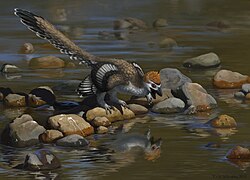 | |
| Zhongjianosaurus | 2017 | Yixian Formation (തുടക്ക ക്രിറ്റേഷ്യസ്, Barremian to Aptian) | Distinguishable by its characteristically elongated legs. Described as a microraptorian[143] but it has been noted that some features of its skeleton are similar to avialans[39] | 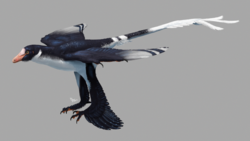 | |
| Zhuchengceratops | 2010 | Wangshi Group (അന്ത്യ ക്രിറ്റേഷ്യസ്, Maastrichtian) | Had a particularly deep mandible |  | |
| Zhuchengtitan | 2017 | Wangshi Group (അന്ത്യ ക്രിറ്റേഷ്യസ്, Campanian) | The proportions of its humerus suggest a close relationship with Opisthocoelicaudia[144] |  | |
| Zhuchengtyrannus | 2011 | Wangshi Group (അന്ത്യ ക്രിറ്റേഷ്യസ്, Campanian) | Closely related to Tarbosaurus and Tyrannosaurus |  | |
| Zigongosaurus | 1976 | Shaximiao Formation (മധ്യ ട്രയാസ്സിക് to അന്ത്യ ട്രയാസ്സിക്, Bathonian to Tithonian) | May be a species of Mamenchisaurus[145] | ||
| Zizhongosaurus | 1983 | Ziliujing Formation (തുടക്ക ജുറാസ്സിക്, Toarcian) | Poorly known but was most likely basal for a sauropod | ||
| Zuolong | 2010 | Shishugou Formation (അന്ത്യ ട്രയാസ്സിക്, Oxfordian | അറിയപ്പെടുന്ന ഏറ്റവും പഴയ കോയ്ലൂറോസറുകളിൽ ഒന്ന്. തലയോട്ടിയുടെയും അസ്ഥികൂടത്തിന്റെയും അവശിഷ്ടങ്ങൾ ലഭ്യമാണ്. |  | |
| Zuoyunlong | 2017 | Zhumapu Formation (അന്ത്യ ക്രിറ്റേഷ്യസ്, Cenomanian) | വടക്കേ അമേരിക്കൻ ഹാഡ്രോസോറോയിഡുകളും ഏഷ്യൻ ഹാഡ്രോസോറോയിഡുകളും തമ്മിലുള്ള വേർതിരിവിന്റെ സമയത്ത് ജീവിച്ചിരുന്നതായി കരുതപ്പെടുന്നു.[146] |  |
അടയ്ക്കുക
Remove ads
ജീവിതകാലം

പേര് ചേർക്കാൻ വേണ്ട അടിസ്ഥാന മാനദണ്ഡങ്ങൾ
- ദിനോസറിന്റെ പേര് മാത്രമേ ചേർക്കാവൂ. (ജന്തു ദിനോസർ ആയിരിക്കണം)
- ദിനോസർ പട്ടികയിൽ പേര് ഉണ്ടായിരിക്കണം.
- പേര് ചേർക്കുന്ന ദിനോസറിന്റെ ഫോസ്സിൽ ഏഷ്യയിൽ നിന്നും ആയിരിക്കണം കിട്ടിയിട്ടുളളത്.
- ഏഷ്യൻ ദിനോസറുകൾ എന്ന വർഗ്ഗത്തിൽ ചേർത്തിരിക്കണം.
- ജീവിച്ച കാലം ചേർത്തിട്ടുണ്ടാകണം.
അവലംബം
പുറത്തേക്കുള്ള കണ്ണികൾ
Wikiwand - on
Seamless Wikipedia browsing. On steroids.
Remove ads
Remove ads